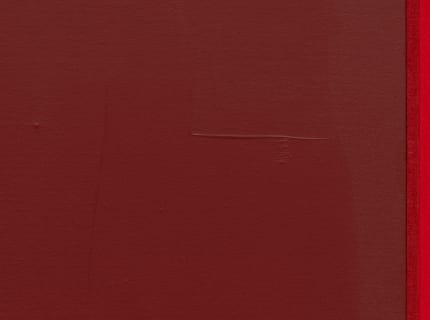For the ambitious exhibition “Out of Easy Reach,” Allison Glenn curated works by twenty-four artists at Chicago’s DePaul Art Museum, Gallery 400, and the Stony Island Arts Bank. The focus was on uses of abstraction since 1980 by black and Latinx artists from across the spectrum of “women.” Plotting a dynamic range of styles, techniques, and historical affiliations, the show was organized around intertwined conceptual frameworks, including mapping, migration, archives, vernacular culture, and the body. Featured artists included Lisa Alvarado, Candida Alvarez, Barbara Chase-Riboud, Maren Hassinger, Juliana Huxtable, Ayanah Moor, and Howardena Pindell.
Despite its breadth, the show did not sacrifice interesting formal dialogues between works. At Gallery 400, the ninety-five black-and-white drawings of Torkwase Dyson’s Untitled (Hypershape), 2017, meditated on the scalar relationship between blueprint and building. Meanwhile, Alvarado’s large-scale painting Traditional Object 21, 2017, compositionally shouted with lush pinks, purples, and blues that activate a rhythmic, tessellated pattern whose forms recall Dyson’s gouache and pen strokes.
Other juxtapositions exemplified aesthetic conversations that are rarely seen or accounted for in a post-1980s history of abstraction. At DePaul Art Museum were Steffani Jemison’s Same Time and Jennie C. Jones’s Gray Measure with Clipped Tone (Inverses), both 2016, chromatically reduced works that involve compositions of two rectangular units forming a corner or an edge, and that manipulate light and sound. When placed in dialogue, the two works reference a muted and intriguing form of Minimalism that also expands into the racialized politics of sight and sound. Jemison’s uses of transparency and opacity offer up questions of what it means to see, be seen, and see through; the transparent film is a window onto the stark white gallery wall behind it, which is in turn marked by her ambiguous black acrylic strokes. Jemison’s aesthetic modulation demonstrates what Caribbean theorist Éduoard Glissant has called the “right to opacity,” a mode of retention, ambiguity, and even secrecy that withholds direct communication in order to refuse the imposition of transparency—which is seen as a violent means of organizing humanity according to white, Western ideals. Meanwhile, Jones’s work explores the places where visual and sonic abstraction meet, turning to histories of jazz as a particularly black avant-garde aesthetic of expression. If black and white function as codes for both race and sound, signifying racial categorizations and the colored keys of a piano, Jones’s material deployment of gray acoustic panels asked us to think of absorption, consumption, and combination as everyday modes of listening across the color line.
While each venue’s exhibition could be discussed as a solitary unit, “Out of Easy Reach” should also be afforded the more difficult task of thinking inter-institutionally. Martine Syms’s stellar ten-photograph installation at Gallery 400 recalled Xaviera Simmons’s On Sculpture #2, 2011, installed at DePaul. Both performatively engage with histories of conceptual photography—Syms’s shaped by the smoggy sunlight specific to Los Angeles and Simmons’s by the ocean’s deep memory of the transatlantic slave trade—in seamless art-historical dérives.
In its focus on abstraction, “Out of Easy Reach” strove to relieve the exhibiting artists of the representational mandates often placed on women artists and artists of color. Abstraction can, after all, dislodge fixed racialized and gendered categories. So, too, can the viewer experience the works free of prescriptive meanings. However, several moments of didactic overreach in the wall texts, pamphlets, and website undercut the rich ambiguity of the exhibition’s nonnarrative presentation, betraying a general lack of trust in viewers’ ability to grapple with abstraction and conceptualism alike.
“Out of Easy Reach” nevertheless shone in its activation of expansive approaches to abstraction, such as Chase-Riboud’s stunning Little Gold Flag, 2007, featured in the architecturally monumental Stony Island Arts Bank: The sculpted mass figures a body capped by a polished bronze cube, which morphs into a strange container that cannot hold the mounds of woven, bundled, and knotted silk emerging from within it. The inadequacy of that rigid constraint spoke to the show’s larger concern for the ongoing and art-historical restrictions on who can use abstraction as a tool. Perhaps, like the fabric in Chase-Riboud’s sculpture, we, too, can be bunched, bundled, knotted, and joined, acknowledging our reflections in the polished bronze surface while finding space for the generatively deformed and the joyously abstract.
...
Read full review at artforum.com.

